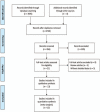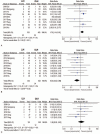Advantages of laparoscopic left hemihepatectomy: A meta-analysis
- PMID: 31169712
- PMCID: PMC6571277
- DOI: 10.1097/MD.0000000000015929
Advantages of laparoscopic left hemihepatectomy: A meta-analysis
Abstract
Background: Laparoscopic left hemihepatectomy (LLH) has been widely accepted as a minimally invasive alternative to open liver surgery. We assessed the benefits and drawbacks of LLH compared with open left hemihepatectomy (OLH) using meta-analysis.
Methods: Relevant literature was retrieved using PubMed, Embase, Cochrane, and Ovid Medline databases. Multiple parameters of efficacy and safety were compared between the treatment groups. Results are expressed as odds ratio (OD) or mean difference (MD) with 95% confidence interval (95% CI) for fixed- and random-effects models.
Results: The meta-analysis included 13 trials involving 1163 patients. Compared with OLH, LLH significantly reduced intraoperative blood loss (MD, -91.01; 95% CI, -139.12 to -42.89; P = .0002), transfusion requirement (OR, 0.24; 95% CI, 0.11-0.54; P = .0004), time to oral intake (MD, -0.80; 95% CI, -1.27 to -0.33; P = .0008), and hospital stay (MD, -3.94; 95% CI, -4.85 to -3.03; P < .0001). However, operative time; complications rate; and postoperative alanine transferase, albumin, and total bilirubin levels did not differ significantly between the 2 surgical groups (P > .05). For hepatolithiasis treatment, there were no significant differences in operative time, residual stones, stone recurrence, and complications rate between the groups (P > .05), but LLH resulted in lower incisional infection rate (OR, 0.44; 95% CI, 0.22-0.89; P = .02) than OLH. The LLH group demonstrated higher bile leakage rate (OR, 1.79; 95% CI, 1.14-2.81; P = .01) and incurred greater hospital costs (MD, 618.56; 95% CI, 154.47-1082.64; P = .009).
Conclusions: LLH has multiple advantages over OLH and should thus be considered as the first choice for left hemihepatectomy.
Conflict of interest statement
The authors declare that they have no competing interests.
Figures







Similar articles
-
Comparison of laparoscopic versus open left hemihepatectomy for left-sided hepatolithiasis.Int J Med Sci. 2014 Jan 2;11(2):127-33. doi: 10.7150/ijms.7516. eCollection 2014. Int J Med Sci. 2014. PMID: 24465157 Free PMC article.
-
Laparoscopic versus open left hemihepatectomy for hepatolithiasis.J Surg Res. 2015 Dec;199(2):402-6. doi: 10.1016/j.jss.2015.06.021. Epub 2015 Jun 16. J Surg Res. 2015. PMID: 26169034
-
Laparoscopic left-sided hepatectomy for the treatment of hepatolithiasis: A comparative study with open approach.Int J Surg. 2017 Apr;40:117-123. doi: 10.1016/j.ijsu.2017.02.068. Epub 2017 Feb 28. Int J Surg. 2017. PMID: 28254607
-
Fully laparoscopic left hepatectomy - a technical reference proposed for standard practice compared to the open approach: a retrospective propensity score model.HPB (Oxford). 2018 Apr;20(4):347-355. doi: 10.1016/j.hpb.2017.10.006. Epub 2017 Nov 21. HPB (Oxford). 2018. PMID: 29169905 Review.
-
Laparoscopic vs. open left lateral sectionectomy: An update meta-analysis of randomized and non-randomized controlled trials.Int J Surg. 2019 Jan;61:1-10. doi: 10.1016/j.ijsu.2018.11.021. Epub 2018 Nov 27. Int J Surg. 2019. PMID: 30496866 Review.
Cited by
-
The safety and feasibility of laparoscopic anatomical left hemihepatectomy along the middle hepatic vein from the head side approach.Front Oncol. 2024 May 24;14:1368678. doi: 10.3389/fonc.2024.1368678. eCollection 2024. Front Oncol. 2024. PMID: 38854724 Free PMC article.
-
Safety and feasibility of laparoscopy technology in right hemihepatectomy.Sci Rep. 2019 Dec 11;9(1):18809. doi: 10.1038/s41598-019-52694-5. Sci Rep. 2019. PMID: 31827122 Free PMC article.
-
Comparative analysis of the safety and feasibility of laparoscopic and open approaches for right anterior sectionectomy.Sci Rep. 2024 Dec 4;14(1):30185. doi: 10.1038/s41598-024-80148-0. Sci Rep. 2024. PMID: 39632910 Free PMC article.
-
Outcomes and Patient Selection in Laparoscopic vs. Open Liver Resection for HCC and Colorectal Cancer Liver Metastasis.Cancers (Basel). 2023 Feb 12;15(4):1179. doi: 10.3390/cancers15041179. Cancers (Basel). 2023. PMID: 36831521 Free PMC article. Review.
-
Laparoscopic distal pancreatectomy versus laparoscopic central pancreatectomy for benign or low-grade malignant tumors in the pancreatic neck.Langenbecks Arch Surg. 2023 Sep 12;408(1):355. doi: 10.1007/s00423-023-03096-9. Langenbecks Arch Surg. 2023. PMID: 37700188
References
-
- Polignano FM, Quyn AJ, de Figueiredo RS, et al. Laparoscopic versus open liver segmentectomy: prospective, case-matched, intention-to-treat analysis of clinical outcomes and cost effectiveness. Surg Endosc 2008;22:2564–70. - PubMed
-
- Kasai M, Cipriani F, Gayet B, et al. Laparoscopic versus open major hepatectomy: a systematic review and meta-analysis of individual patient data. Surgery 2018;16:985–95. - PubMed
Publication types
MeSH terms
LinkOut - more resources
Full Text Sources
Medical
Miscellaneous

